

Full mouth reconstruction refers to rebuilding and/or replacing all of the teeth in a patient’s mouth. Full mouth reconstructions combine aesthetics with the science of restorative dentistry to improve the health, function, and beauty of the mouth.
CROWNS
Crowns cover or “cap” a tooth to restore the normal function and appearance of the tooth. Crowns may be made as all metal, porcelain fused to metal, or all-ceramic (porcelain).
BONDING
Bonding may be used to attach tooth-colored filling material to your teeth or with types of special cement to attach certain restorations to your teeth.
WHITENING
Custom fabricated trays with a whitening gel, or whitening in our office using UV light or laser as the catalyst may be used.
FILLINGS
Fillings replace lost tooth structure due to tooth decay or fracture of a tooth. In advanced cases of lost tooth structure, porcelain or gold crowns and onlays may be required. In simple cases, the missing tooth structure can be replaced with dental fillings using composites or amalgam.
MOUTHGUARDS
This is a resilient device that is worn on either the upper or lower teeth to protect the teeth from trauma during contact sports or any activity that might result in a blow to the mouth or jaw.
DENTURES
Dentures are replacements for missing teeth. Complete dentures replace all teeth and removable partial dentures replace some teeth.
DENTAL IMPLANTS
Dental implants are metal cylinders made of titanium surgically placed in the jawbone where teeth are missing. Implants replace the roots of missing teeth and support single crowns, large bridges, and dentures. State-of-the-art technology makes it possible for these implant-supported replacement teeth to look, feel, and function like natural teeth.
VENEERS
Porcelain veneers are used to modify the shape and color of teeth, and they are the treatment of choice for teeth that are relatively intact but may be misshapen, discolored, or chipped.
INLAYS & ONLAYS
Traditionally, inlays were used instead of fillings to replace a smaller amounts of tooth structure loss due to decay. Onlays also fit inside the tooth, but extend onto the chewing surface of a back tooth to replace one or more cusps.
BRIDGES
A fixed bridge technique has been used with high success for many years to replace a missing tooth or teeth. Teeth on both sides of the space left by the missing tooth are prepared for a crown. Then a false tooth is joined to the crowns, and the entire bridge is cemented to the prepared teeth.
TMJ/TMD TREATMENT
The temporomandibular joint (TMJ), when not functioning properly, can cause a tremendous amount of pain. The tissues behind the joint (retrodiscal tissues) have many nerves that run through them. Once they become inflamed, any slight pressure will cause pain and perpetuate the problem.
OCCLUSAL SPLINTS
An occlusal splint or orthotic device is a specially designed mouthguard for people who grind their teeth, have a history of pain and dysfunction associated with their bite or temporomandibular joints (TMJ) or have completed a full mouth reconstruction.

